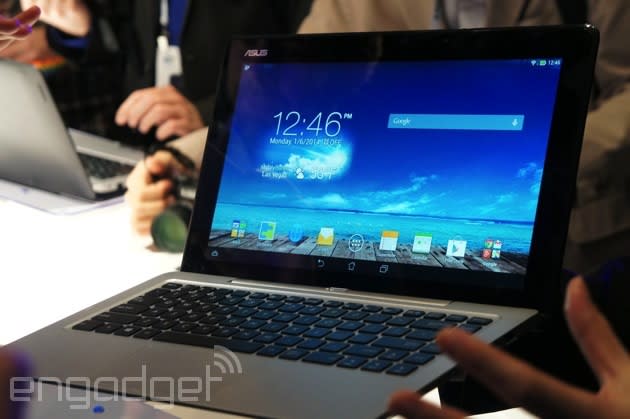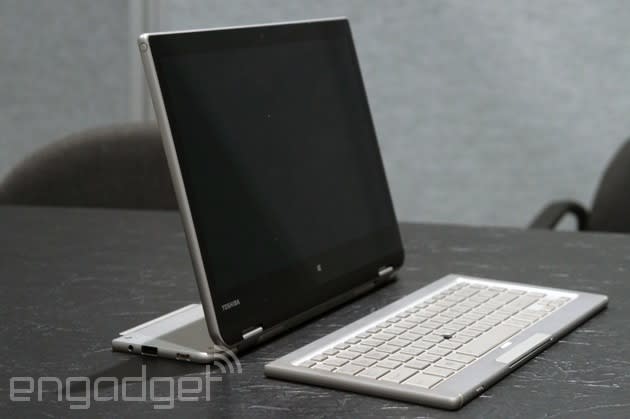CES 2014: Laptops roundup

It wasn't exactly a banner year for laptops at CES. Hell, the "Best of CES" award for PCs ended up going to a desktop, and was nearly upstaged by an all-in-one running Chrome OS. Still, that didn't stop some companies (especially Lenovo) from trotting out new models. From a simple Haswell refresh to a dual-OS hybrid, we've rounded up every laptop announced at the show. Couldn't keep up with all the news the first time? Get ready to catch up right here.
ASUS Transformer Book Duet

ASUS only announced one laptop at this year's CES, but it's quite the doozy, even by itself. In brief, the Duet is a 13-inch laptop/tablet hybrid that runs both Windows and Android. Unlike ASUS' earlier Transformer Book Trio, though, which only ran Android in tablet mode, the Duet can run either OS, regardless of whether you have it plugged into the keyboard dock. As with the Trio, however, you can expect an abundance of storage: up to 128GB in the tablet and up to 1TB in the dock portion.
Lenovo Ideapad Y40, Y50, Z40 and Z50

Don't say we didn't warn you about the refreshes. In addition to unveiling a new line of laptop/tablet hybrids (more on that in a moment), Lenovo also made slight tweaks to its performance Y series and its multimedia Z line. Most notably, the 15-inch Y50 now has a 3,840 x 2,160 screen configuration, along with an optional touchscreen and backlit keyboards -- all things you won't find on the smaller Y40. With the Z series, the specs are more similar between the Z40 and Z50: Either way, you get an optional NVIDIA 840M GPU, along with Haswell processors, up to 16GB of RAM and a 1,366 x 768 display (upgradeable to 1080p). Finally, wrapping up, Lenovo also refreshed its existing Flex 14 and 15 laptops with AMD processors. And... that's it. They otherwise have the same Yoga-like design as the current models.
Lenovo Miix 2

Last year at CES, Lenovo nearly stole the show with the ThinkPad Helix, a laptop/tablet hybrid that you could use with the screen facing away from the keyboard. Fast-forward a year, and the Miix 2 series is basically the same design, except: A) it's a consumer product; B) it doesn't allow for pen input; and C) it's much sleeker than the original Helix was. Available in two screen sizes, 10 and 11 inches, you get a 1080p screen on either model, though the 11-incher runs on a much more powerful chip (Core i5 versus Intel Bay Trail on the Miix 2 10). Performance aside, they're more alike than they are different: Both offer an eight-hour battery, optional 3G, JBL speakers and a full-sized USB port on the dock itself.
Lenovo ThinkPad X1 Carbon

A year and a half after the original ThinkPad X1 Carbon came out, our favorite business Ultrabook is getting refreshed in a big way. In addition to the usual Haswell processors, it now has a 2,560 x 1,440 screen option and an "adaptive" keyboard with light-up controls along the top that change depending on the application you're using. It's also something of an engineering marvel: Even with a touchscreen, it comes in at around three pounds, making it the lightest 14-inch laptop we know of.
Lenovo Yoga 2

Remember when Lenovo's Yoga line consisted of just two models: an 11-incher and a 13-inch model? Those were the days. After releasing the ThinkPad Yoga and high-end Yoga 2 Pro a few months earlier, Lenovo is back with the mid-range Yoga 2 series, which effectively replaces the original Yoga 11 and Yoga 13. Starting with the 13-inch model, the screen resolution is now 1,920 x 1,080, instead of 1,600 x 900, and it also steps up to a backlit keyboard and eight-hour battery. Still, the Yoga 2 Pro goes up to 3,200 x 1,800 for not much more money ($1,199 versus $999 for the Yoga 2 13). Also, the Yoga 2 Pro offers solid-state storage, whereas the Yoga 2 makes do with spinning hard drives. As for the 11-inch model, it now runs full Windows, thanks to an Intel Bay Trail processor, meaning it should be more powerful (and also more versatile) than the now-discontinued Windows RT version.
Samsung ATIV Book 9 2014 Edition

Though this technically falls into the "refresh" pile, Samsung's ATIV Book 9 2014 Edition still made it into our Best of CES finalist round, mostly thanks to its superior sound quality. With support for lossless formats (via the headphone jack or a compatible speaker), the ATIV Book 9 brings richer, more studio-like sound -- a meaningful improvement over what you'd get on most other laptops. Indeed, we hope this is a harbinger of better things to come throughout Samsung's PC lineup, if not the rest of the industry.
Sony VAIO Flip 11A

Sony's already been taking on Lenovo's Yoga series with its new Flip line, but early reviews (including ours) were lukewarm, mostly because Sony's convertibles were on the large side, making them unwieldy to use in tablet mode. Accordingly, then, Sony's coming out with an 11-inch model, the Flip 11A, which should be easier to use as both a laptop and tablet (its cramped, netbook-like keyboard notwithstanding). Like its bigger siblings, it offers pen support, with the help of an N-trig digitizer, and also comes pre-loaded with artsy software like Artrage and Photoshop Elements. Is it revolutionary? Hardly, but with its smaller footprint, it could be easier to use. And hey, its $800 starting price is tempting, too.
Toshiba Chromebook

It was a pretty quiet year for Toshiba. Other than a few TVs and a couple of laptop PCs, all the company had to show was a single Chromebook. Granted, this was Toshiba's first Chromebook, which is sort of an interesting story in and of itself: It's basically the last major PC maker to jump on board. The $279 Toshiba Chromebook, as it's so very appropriately called, has a 13-inch screen, which, for whatever reason, has never been used on a Chrome OS device before. Under the hood, it runs off a Haswell-series Celeron 2955U CPU -- a nice boost over the sort of ARM processor used in the identically priced HP Chromebook 11. Additionally, that larger footprint means the Toshiba Chromebook offers a more spacious keyboard than most, along with deeper key travel, too. It may not have been groundbreaking enough to win a Best of CES Award, but among Chromebooks, at least, it looks like it might actually be a good deal.
Toshiba 5-in-1 laptop concept

Like it did with netbooks and Android tablets, Toshiba initially sat out the convertible notebook trend, opting instead to watch its competitors very closely. Finally, though, the company is getting ready to enter the space: It spent the week showing off a 5-in-1 laptop that takes after Lenovo's Yoga series, while avoiding some of its mistakes. In particular, this 13-inch device (name TBD) has a reversible, detachable keyboard; slip it off and you'll be left with a small piece of metal at the top of the keyboard deck that folds back into a kickstand. From there, you can use the laptop in "tent" mode, "canvas" mode (with the screen face-up at a slight angle) and a sort of presentation mode.
When it comes to using the thing as a standalone tablet, you can reattach the keyboard with the buttons facing in, meaning you won't have to press your fingers against loose keys, like you would on a Yoga. Additionally, the laptop has a built-in pen slot -- a nice touch, considering most of its rivals don't support pen input at all. No word on when this will go on sale, how much it will cost or what specs it might offer -- all Toshiba reps are saying right now is that the company will release the device when it's ready.
Toshiba Satellite P50t

One trend Toshiba isn't sitting out? High-res laptop displays. After being one of the first companies to ship a notebook with a 2,560 x 1,440 screen, it's on track to be first out of the gate with a 4K notebook. The Satellite P50t, set to come out later this year, has a 15-inch, 3,840 x 2,160 display with a pixel density of 282 ppi. As we've seen on every other super-high-res laptop (the Retina display MacBook Pro, the Samsung ATIV Book 9 Plus, et cetera), not all apps have been optimized for such a high pixel density, so you're bound to see some awkward scaling (think: tiny playback controls in Windows Media Player). That said, the screen itself is lovely, with good viewing angles and fine color reproduction. Keep this one in mind six months from now when back-to-school season comes around; hopefully this guy will be ready by then.
Vizio 15.6-inch Thin + Light

It's sort of insane to think that Vizio is only just getting around to releasing its first Haswell laptop, but hey, better late than never, right? Here at CES, the company announced a refreshed version of its 15.6-inch Thin + Light, which now comes standard with a quad-core Core i7 processor, Intel Iris Pro graphics and a 1080p touchscreen. Other than that, this has the same design as the laptops Vizio put out last year, which is to say it has a metal chassis with flat, close-together keys. Interestingly, though, the selection of screen sizes has dwindled since a year ago: though Vizio refreshed its 15-inch laptop, it's apparently discontinuing the 14-inch model. Looks like Vizio decided not to compete with Ultrabooks after all.

